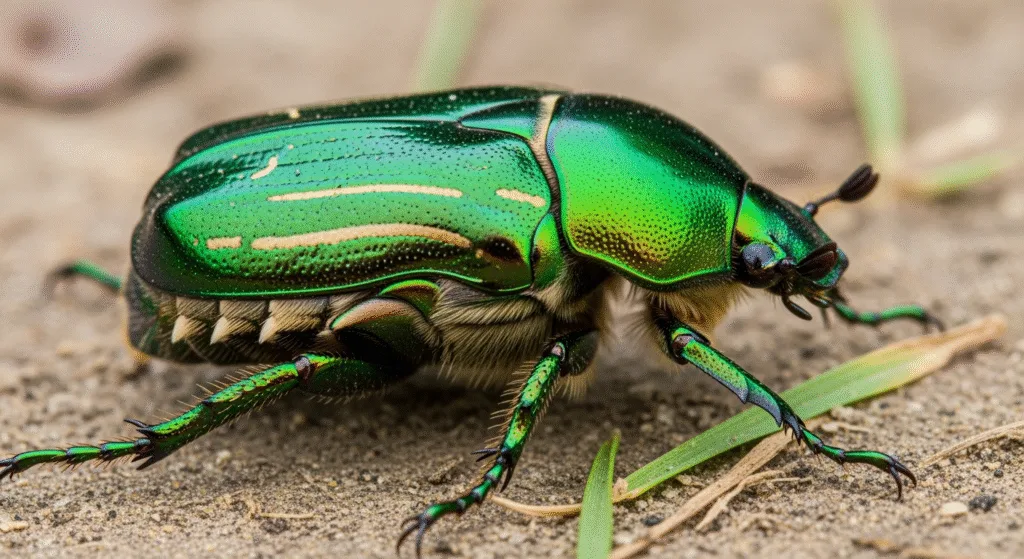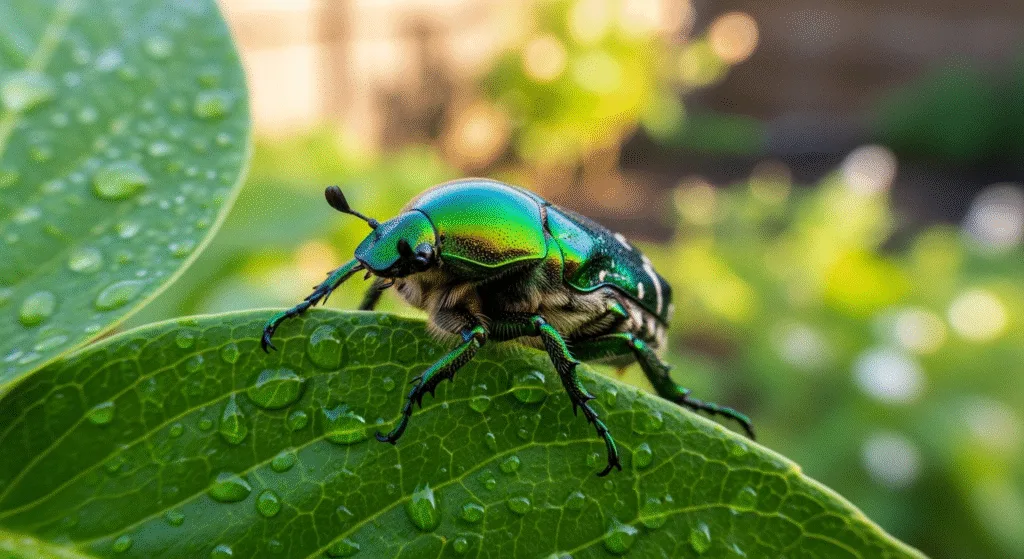Why June Beetles Matter to Fruit Growers
Fruit growers know the dangers lurking in orchards and fields during late spring and early summer. One of the most notorious pests is the green june beetle, a metallic green insect that emerges in large numbers and can wreak havoc on crops. This insect, formally known as Cotinis nitida, causes alarm because its larvae and adults feed on different parts of plants. While the sight of dazzling beetles flying around might seem harmless at first, an unchecked infestation can cost growers significant losses in fruit quality, yield, and long-term soil health.
In this article, we will dive into everything fruit growers need to know about the green june beetle—from its life cycle and habits to prevention and management strategies. Whether you manage a small orchard or oversee acres of commercial fruit production, understanding this pest is key to protecting crops and staying ahead. This guide will provide clear insights, backed by agricultural best practices, to help you make informed decisions during the critical summer months.
Understanding the Life Cycle of June Beetles

The life cycle of the green june beetle explains why these insects seem to appear suddenly every year. Their development includes four stages: egg, larva, pupa, and adult. Each stage plays a different role in damaging crops or soils.
Egg Stage
Female beetles lay eggs in moist organic soils, often in lawns, orchards, or fields with abundant organic matter. Eggs hatch within two weeks, setting the stage for one of the most harmful stages—the larvae.
Larval or Grub Stage
The larvae, or white grubs, are perhaps the most damaging. These C-shaped grubs feed on roots of grasses and plants, weakening soils and making it difficult for orchards to absorb water properly. Growers often notice patches of wilted grass and fruit crops failing to thrive due to this feeding activity.
Pupal Stage
After feeding for several months, larvae enter the pupal stage in the soil. During this time, they undergo metamorphosis, eventually emerging as adults.
Adult Stage
By late May or June, adult beetles emerge. These glittering green beetles swarm fruit trees, feeding on ripe or ripening fruit, especially peaches, plums, and grapes. This is when growers face immediate and visible damage—fruit skins scarred, punctured, or left rotting on trees.
Understanding this cycle gives fruit growers a major advantage. Knowing when larvae feed or adults swarm helps you time preventative measures and management techniques for maximum effectiveness.
How Green June Beetles Damage Fruit Crops
The green june beetle inflicts damage in multiple ways that concern both the short-term harvest and the long-term health of orchards.
Root Damage from Grubs
The grub stage poses one of the most invisible but severe threats. As larvae feed on roots underground, the soil structure suffers. For example:
- Roots of fruit trees weaken, causing reduced stability.
- Lawns and orchard groundcovers die in patches.
- Weakened trees become more susceptible to drought.
Fruit Feeding by Adults
Perhaps the most dramatic damage occurs when adults appear. These beetles have powerful mandibles that allow them to slice through fruit skins. Typical symptoms growers notice include:
- Scarring on peaches and apples.
- Pierced grapes, which quickly rot in clusters.
- Fruit falling earlier than expected or splitting open due to wounds.
Secondary Problems Caused by Beetles
The damage goes beyond feeding. Once beetles bruise and pierce fruits, molds, bacteria, and other pests move in. This secondary infection can spread quickly across a crop, accelerating losses dramatically.
For fruit growers, these problems compound into serious financial risk. A single outbreak of green june beetle activity can devastate a season’s crop if ignored.
How to Identify Green June Beetles
Correct identification of the green june beetle is crucial, especially since other shiny beetles can appear during the same season. Fortunately, several distinct traits help growers distinguish them from other insects.
Adult Identification
Adult beetles measure about 1/2 to 1 inch long, with a bright metallic green coloration on their top wings and sometimes bronze or gold highlights. They fly noisily around midday, often in warm sunlit areas, making them easy to spot in orchards.
Larval Identification
The larvae are typical white grubs—C-shaped, whitish with darker heads, and found rolled up in soil. A distinctive clue is their movement. Unlike other grubs, green june beetle larvae move upside down, crawling on their backs using stiff bristles on their bodies.
Pest Look-Alikes
Other beetles, like Japanese beetles or May beetles, are often mistaken for the green june beetle. However, Japanese beetles are smaller, with copper and metallic green patterns, while May beetles lack the metallic shine. Spotting the crawling-backward behavior of the larvae is another sure method of positive identification.
Preventing Infestations Before They Happen

Prevention can save growers extensive trouble when dealing with the green june beetle. By adopting proper agricultural practices, orchard environments become less inviting to these pests.
Soil and Lawn Management
- Reduce organic matter buildup by managing compost and mulch layers carefully.
- Aerate soils regularly to reduce the damp conditions beetles prefer for laying eggs.
- Avoid overwatering lawns and orchard areas since moist soils attract egg-laying females.
Fruit Protection Tactics
Covering fruit with protective nets can minimize beetle feeding during peak adult flight seasons. Additionally, maintaining orchard hygiene by promptly removing fallen or overripe fruit reduces the chances of beetles being drawn in masses.
Biological Barriers
Encouraging natural predators like birds and parasitic wasps helps reduce population build-up naturally. For example, bluebirds and robins frequently feed on grubs in the soil. Promoting these beneficial species can lead to a healthier orchard with lower pest pressure.
Effective Management and Control Options
Despite best efforts, infestations can happen. Understanding how to manage green june beetle populations when they surge is essential. Effective control combines cultural, biological, and chemical strategies, depending on the severity.
Cultural Controls
Removing organic debris, tilling orchards in late spring, and mowing grassy areas reduce breeding grounds. These steps disturb larvae and prevent adult emergence in large numbers.
Biological Controls
Beneficial nematodes, such as Heterorhabditis bacteriophora, prey on beetle larvae within soils. Applying them in late summer when grubs are active significantly reduces populations. Birds and small mammals also act as allies when encouraged in orchard landscapes.
Chemical Options
In cases of severe infestations, insecticides may provide relief. However, growers should use them cautiously and according to local guidelines to prevent resistance or environmental harm. Spot treatments often perform better than blanket applications for fruit growers aiming to protect beneficial insects.
Long-Term Orchard Health and Resilience
June beetle management should not only focus on one season but strengthen orchards for the long haul. Healthier trees recover faster and withstand pest assaults more effectively.
Crop Rotation and Diversity
Diversifying crops where possible reduces pest buildup. Monocultures attract concentrated pest populations, while a mix of crops creates resilience.
Soil Health Programs
Enriching soils with balanced nutrients, organic matter, and microbial life ensures strong root systems. Even if larvae feed in these soils, well-nourished trees cope better with root loss. Practices such as cover cropping or adding compost teas improve soil biology and limit beetle-friendly environments.
Integrated Approach
The key lies in layering strategies—prevention, biological allies, cultural tactics, and, where needed, targeted controls. With integrated pest management as a guiding principle, growers can balance crop productivity with ecological health, keeping the green june beetle challenge under control year after year.
Conclusion: Staying Ahead of the June Beetle Season
June beetles, particularly the green june beetle, continue to challenge fruit growers each year. However, by understanding the pest’s life cycle, recognizing damage signs, and applying preventive and responsive strategies, farmers and orchardists can minimize losses and protect their harvests. The key is vigilance—monitoring orchard soils and fruits, preparing early management plans, and building long-term resilience. With the right knowledge and timely actions, fruit growers can safeguard their crops and maintain profitable and healthy fruit production, even when beetles arrive in swarms.



